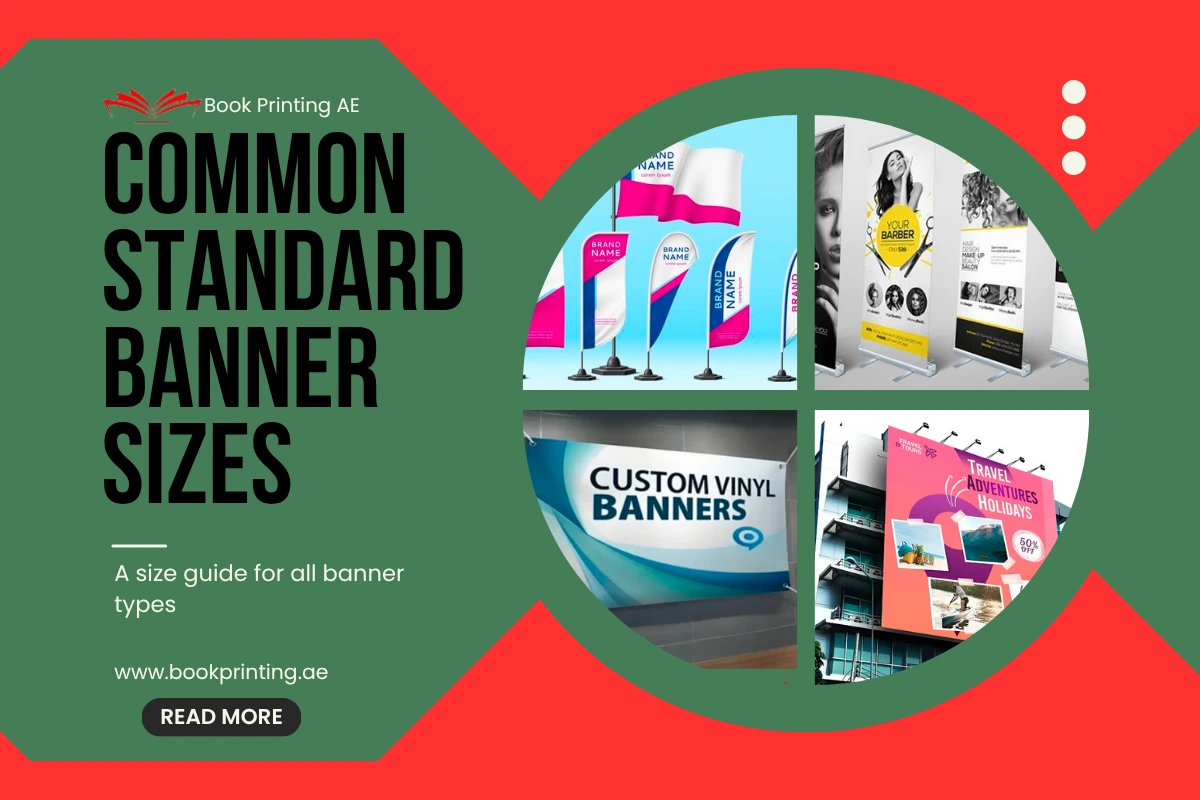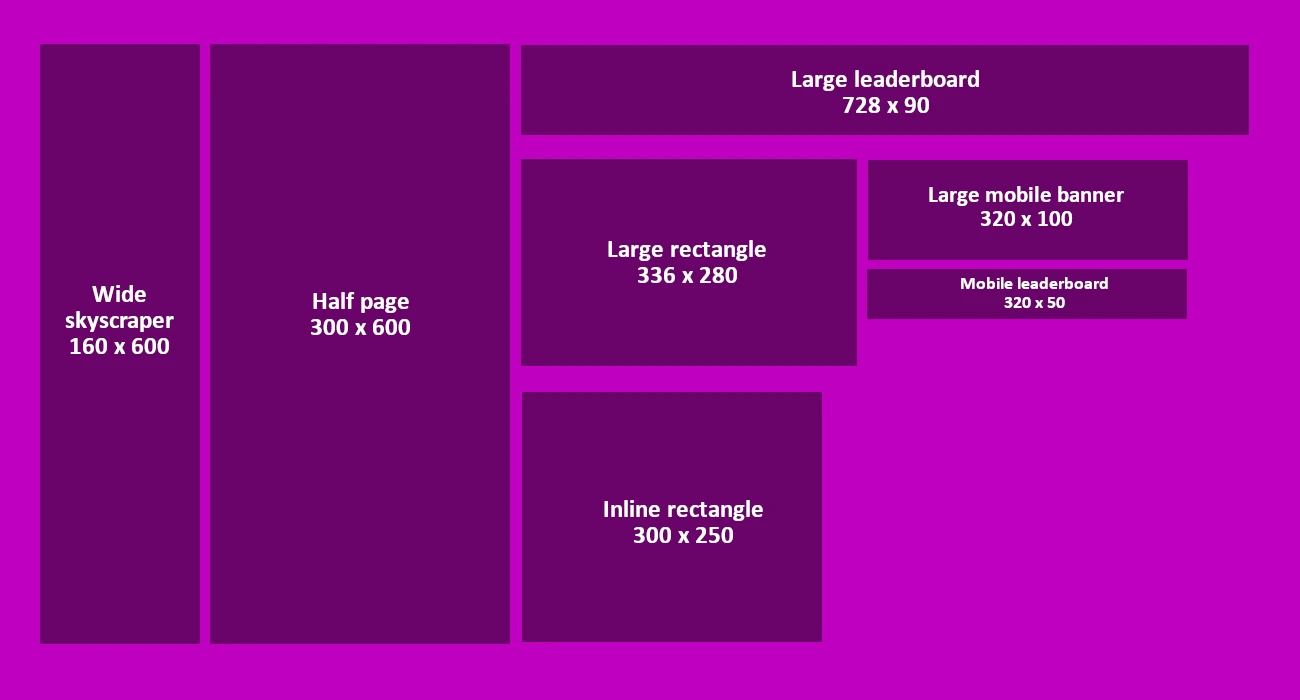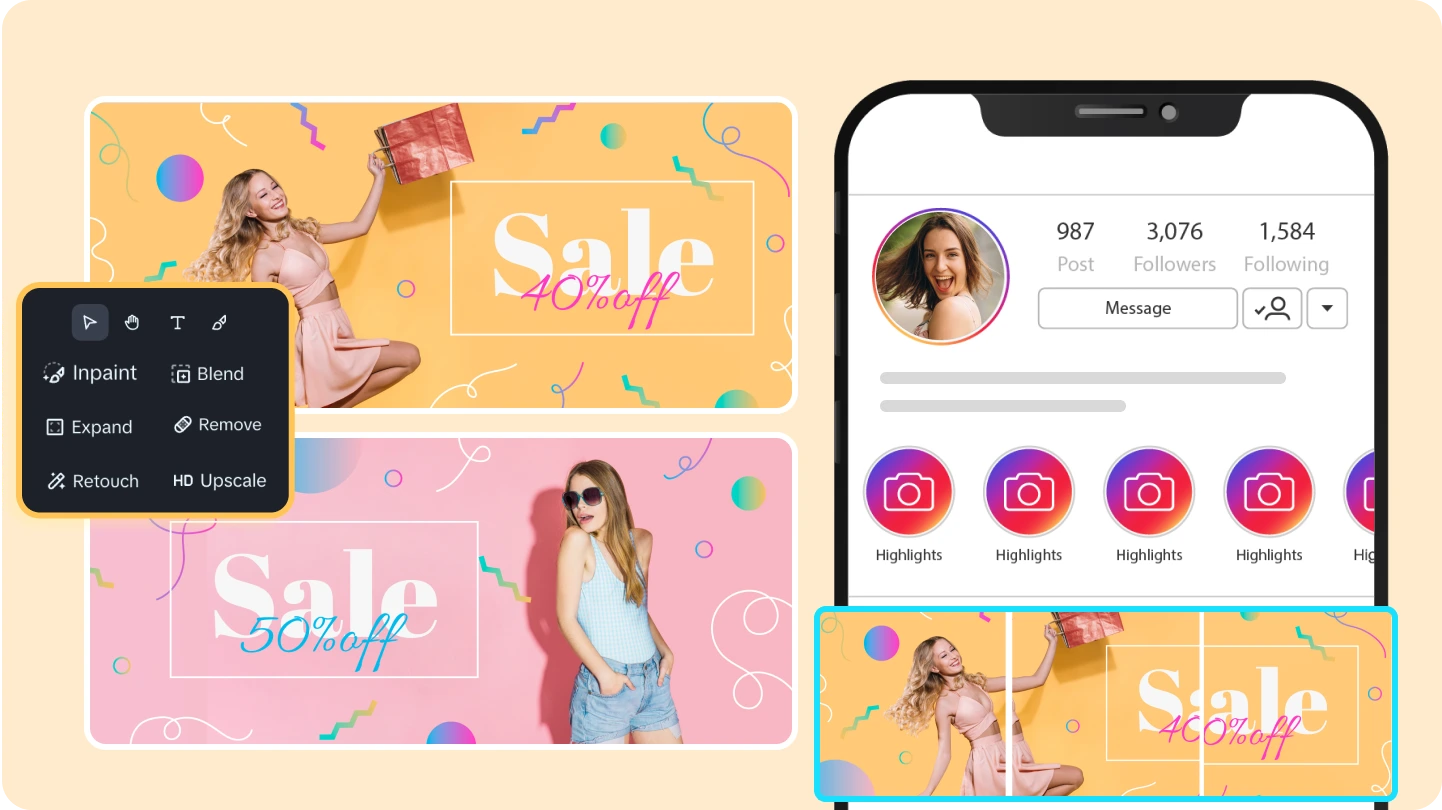A Guide to Common Standard Banner Sizes for All Purposes

A banner is a long strip of cloth or paper with a design, message, or advertisement on it. Many brands use it for decoration. However, it is originally an advertising tactic.
In digital contexts, a ‘banner’ commonly refers to a rectangular commercial that appears on a webpage or on a printed sheet displayed on a skyscraper.
An important aspect of these banners is the standard banner sizes. Something that is often overlooked by those new to promotional design. So, here is a full-fledged article on choosing the right banner size.
The Only Banner Size Cheat Sheet You Will Ever Need
There are many types of advertising banners that are used to convey a brand’s message to the target audience. Some might be digital, and some physical. A few can be life-size, while some of them can be small enough to fit on a phone’s screen. Here are the 6 classic types that you must know about for better design decisions and ultimately better reach.
1. Web Banners
These ads appear on websites and apps to promote products or services. For example, Canva recently used a 728×90 leaderboard banner to promote its new Docs feature on design blogs. These banners are placed at the top or sides of pages and often include animations or calls-to-action to drive clicks.
2. Mobile Banners
They are designed for small screens and in-app ads. That one time, Disney+ also used it to run a 320×50 banner ad inside mobile games to promote its streaming service. These banners are naturally compact. They load quickly and also fit seamlessly into mobile interfaces. Thus, all the users can experience them on the go without being disturbed in what they were doing.
3. Social Media Banners
The flyer printing is no doubt an effective way to reach out targeted audience. However, the social media promotional ads are giving it tough competition lately. They say your social media banner has to be tailored to each platform’s layout. For instance, a local business uses a 1080×1080 square Instagram tile to promote its seasonal drinks.

In the same way, Facebook prefers 1200×628 pixels for ads, while LinkedIn uses 1128×191 pixels for cover posters. This shows that each platform has different sizes, and it is important for a professional image in the public eye.
4. Print Signs
On the topic of standard banner sizes, the next example is of print signs. They are physical and used at events or storefronts. At trade shows, several businesses are seen using 3×8-foot entrance banners for tech expo exhibitions. These display ads don’t just help guide attendees, but they also build brand presence. Therefore, high-resolution printing is important. It makes sure that the advertisements look crisp even at large sizes.
5. Pop-Up or Roll-Up Banners
The roll-up banners are portable and perfect for exhibitions. We say this because it has been used by companies and they all reviewed it in favor of it. Just a handful of bold colors and product highlights. That is it. The vertical displays are also easy to set up and transport, making them a favorite for quick branding at events, booths, or presentations. The dimensions are usually a standard ratio of 800 mm x 2000 mm.
6. Google Ad Banners
Finally, Google Ads supports a range of standard display sizes for display campaigns. According to the experts, these rectangular posters use either 300×250 or 728×90 measurements on different platforms. The sizes are set values because they perform well on the Google Display Network. Experts also explain how they offer high visibility and click-through rates when paired with strong visuals.
Studying the 3 Banner Types in Greater Detail
Web Banners
They are the backbone of online advertising. Appearing on the websites, blogs, and apps (usually at the top of the content), they are designed to grab attention without interrupting the user experience. Hence, they matter.
Users get tempted by them and easily mouse-click on them to visit he advertised brand. This is great for businesses looking for actual visitors into buyer conversions. A pro tip is that you should keep your message short and visuals clean.
Moreover, use call-to-action buttons like ‘Shop Now’ or ‘Learn More’ to guide the user experience. The ideal size for such display ads on the website is 728×90 or 300×250.
| Web Banner Sizes | |||
| Size (px) | Name | Best Placement | Purpose |
| 728×90 | Leaderboard | Top of webpages | High visibility, hence ideal for branding |
| 300×250 | Medium Rectangle | Sidebar or in-content | Versatile and brings high engagement |
| 160×600 | Wide Skyscraper | Sidebars | Vertical format and good for scrolling |
| 970×250 | Billboard | Large header | Bold messaging and strong visual impact |
Mobile Banners
It is no rocket science to guess that mobile banners were built for phones and tablets. However, guessing which dimensions to use for a professional image is what people consider to be something hard to learn. We want to break that myth, and thus, here are the measurements you need to ensure your design fits into that tiny screen without annoying the audience.
Test sizes are 320×50 and 300×250. You can try either to see which performs best in your app or mobile site. But this alone is not enough. It is also required that you opt for bold fonts and minimal text. This rule is necessary to follow when the space is limited. You don’t want any clutter that can make the potential buyer’s interest fade.
| Mobile Banner Sizes | |||
| Size (px) | Name | Best Placement | Purpose |
| 320×50 | Mobile Leaderboard | Top/bottom of mobile screens | Compact, unobtrusive, and fast-loading |
| 300×250 | Medium Rectangle | In-content mobile ads | High performance and adaptable |
| 320×100 | Large Mobile Banner | Mobile apps | More space for visuals and CTA |
Print Banners
Next, we have the banner printing, which are physical signs used at events, storefronts, or exhibitions. They are measured in feet or inches and need high-resolution files to look sharp. They matter because they help businesses create brand presence in real spaces.
So, those who want greater local visibility should use this banner. To make it even more impactful, experts suggest that you go for large fonts, high-contrast colors, and simple messaging. This is what will allow the people to understand everything, even from a distance.
Also, you can go for the size that fits the locations. Huge size for outdoors and compact for indoors. In order to find more answers, you can refer to the chart below for a better understanding.
| Print Banner Size | |||
| Size (px) | Name | Best Placement | Purpose |
| 2×6 | Compact Banner | Indoor events and storefronts | Easy to transport and space-saving |
| 3×8 | Trade Show Banner | Booths and exhibitions | Balanced size for visibility |
| 4×10 | Outdoor Banner | Building fronts and large events | Maximum impact and long-distance view |
What is The Standard Banner Size? Let’s Break It Down
Think of banner sizes like clothing sizes. They are just dimensions that help your design fit just right wherever it is shown. A ‘standard banner size’ simply means a commonly used measurement that works well on any chosen platform, like websites, cellphone apps, social media, or billboards.
According to the studies, a wide banner size in pixels, like 728×90, sits neatly at the top of a web page. Whereas, on mobile, smaller posters like 320×50 pixels fit perfectly.
The main reason for this difference is the significant difference in screen dimensions. Smaller ones have higher chances of squishing the design. On the other hand, social media platforms each have their own preferences too.
Such that Instagram loves squares, while Facebook prefers rectangles. Therefore, using standard sizes means your display ad won’t get cut off, stretched, or ignored.
The All-Purpose Banner Size Chart
Whether you are promoting a product, announcing an event, or simply sharing a message, you must choose the right size of banner. This helps it do its job of increasing visibility smoothly.
This calls for a banner size chart. Something that will act as a guide to match whether you are or are not opting for the right dimensions. Closely study the images below and save them for later use.

Factors to Consider When Choosing Banner Sizes
Reminder: this discussion is not just about a technical detail. It goes beyond that and helps a business get both visibility and engagement. Experienced professionals say that the best poster size depends on the intention behind it and the platform or location where it will be displayed.
So, let us explore the factors that are important to consider before you decide on a digital or rollup banner size. Your first step as a designer is to ask yourself four important questions.
- Is it for web or print?
- Who’s the audience?
- What’s the message?
- Where will it appear?
To explain this in simple words, let’s discuss the purpose first. Whether it is a digital or physical ad poster, the goal behind it should be clear. Then only you will be able to decide the right way to present it to the audience. For instance, if the goal is to invite more clicks, go for the exact formats suggested by experts. But if it is a printed poster, you must know where it will be hung.
- A distant banner should be large enough for viewers, like in billboards
- A close-up poster can be smaller, as it will then be visible to the audience.
The placement also matters. You need to be sure about the location before designing PVC banners or any other kind of advertisement. Is it going to be hung? Will it be placed on a stand? The proportions will be a perfect fit if you know all the answers.

After that, the next thing to worry about is the target audience, especially when you consider designing digital posters. The trick is simple. You need to watch out for what devices your audience uses. It could be desktops, tablets, or mobile. Once you know what the majority is using, you can choose sizes compatible with their screens.
Best Practices for Banner Design and Printing
Have a Strategy First
Choosing the right banner size for printing is like picking the right stage. If it is wrong, your brand image will land flat in the eyes of the audience. Therefore, a 2×6 ft. banner might work for a cozy indoor setup, but a 4×10 ft. one screams ‘look at me’ from across the street. This proves that the designer must always match size to location and viewing distance.
Design Like You Mean It
Yes. Rightly said. You need to skip the clutter and go for one bold message only. This is crucial because one clear image and one strong CTA can be your recipe to establish the desired image in the public. Experts say that you can also use appropriate fonts that are readable from a distance. They give your design some room to breathe. The white space, on the other hand, is also a significant element. Often taken for granted and skipped, these spaces are what make your content pop.
Play with Colors
The psychology of colors can be your secret weapon to win attention wherever required. It is a scientific fact that every shade has a hidden subtext. Think about it and you will notice how brands use red to create urgency, blue to build trust, and yellow to spark energy.
This is a reminder that you shouldn’t be picking random colors or just stick to your favorite ones. You have a variety of shades in the palette, so go for what subtext you want to convey to your audience. Also, remember to test contrast.
Make Sure to Print Smart
Pause. Don’t hit that ‘print’ button. Instead, first zoom in and inspect every detail. You might notice blurry logos, misspelled words, and misaligned elements. No design should ever be displayed with such slipups. They need to be fixed immediately and then only sent for publishing/printing. Moreover, if possible, print a small test version, and work with a printer who understands your goals.
Frequently Asked Questions about Banner Designs
What are the banner sizes that work best for mobile ads?
Popular mobile display ad sizes include 320×50, 300×250, and 320×100 pixels. These fit well on small screens and load quickly. Hence, they are ideal for cell phone apps and websites as they don’t overwhelm the user.
How do I choose the right dimensions for social media?
Each platform has its own recommended sizes. For example, Facebook prefers 1200×628 pixels for ads, while Instagram uses 1080×1080. So, you must always check platform guidelines so that the display ad looks sharp.
Can I use the same size for a desktop and a cellphone?
No. Not always. Desktop banners are usually larger, while mobile banners need to be smaller and responsive. Therefore, using one size for both can lead to poor visibility or layout issues.
Where can I find templates for such design purposes?
You can use tools like Canva, Adobe Express, and Figma. They offer free templates for several designs and dimensions. Also, they are pre-sized and easy to customize, even for beginners.
Wrapping It Up
If whatever we have discussed so far about the standard banner sizes in a single sentence, it will be safe to say that the right poster can benefit a company in three ways. First, it enhances the professionalism of the brand’s promotional efforts. Secondly, it attracts potential customers and brings in the aimed reach in the right way.
Lastly, the company gets to experience the impact of clear communication. They achieve the goals and become successful in reinforcing the brand identity. So, no matter what you do, either hire a professional to ensure consistent sizes across each platform, or simply save this article and learn from it.
